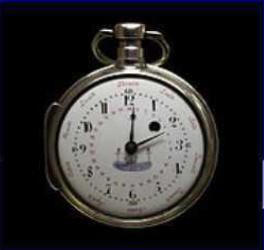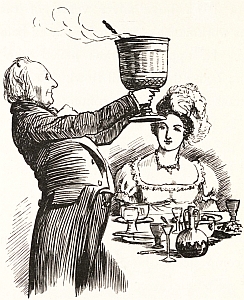
On this day in 1793 the new National Convention in Revolutionary France decreed that Year II of the Republic had begun the day before. However, in October they decided that the Revolutionary year should begin on the Autumn Equinox and retrospectively made 22 September 1792 the first day of Year I.
By choosing a radical and rational reform of the Calendar the Revolutionaries were following Julius Caesar’s example, but unlike Caesar who introduced the Julian Calendar, they almost completely ripped up the calendrical rule book
Let’s start with the names of the months. The concept of the month they kept but got rid of the irrational Latin-based names and replaced them by neologisms designed to hint at the seasons and the weather. I’m going to begin by giving you the names as reported, satirically, by John Brady in England 1811 (starting with ‘October’ and separating seasons by semicolons).
Wheezy, Sneezy and Freezy; Slippy, Drippy and Nippy; Showery, Flowery
and Bowery; Hoppy, Croppy and Poppy.
The historian Thomas Carlyle suggested somewhat more serious English names
in his 1837 work ‘The French Revolution: A History’ namely:
Vintagearious, Fogarious, Frostarious, Snowous, Rainous, Windous, Buddal,
Floweral, Meadowal, Reapidor, Heatidor, and Fruitidor.
The actual revolutionary names were: Vendémiaire, Brumaire, Frimaire; Nivôse, Pluviôse, Ventôse , Germinal, Floréal, Prairial; Messidor, Thermidor, Fructidor
Today is 13th Nivôse, Year 232 according to the calculator at French Calendar.
The year began with the Autumn Equinox and each month was a rational 30 days, leaving 5 days of the solar year to be sorted out. These were given to the Sans Culottes as holidays and called complimentary days. The leap year was similarly given to the Sans Culottes; an extra day, every 4 years. It was a copy of the Egyptian year, which had inspired Caesar to make the Roman year rational.
And like the Egyptians, the 7-day week went out the window. The month was divided into three décades of 10 days, with the tenth day, the décadi, being a day of rest. In effect, by my calculations, the ‘lucky’ Sans Culottes gained 5 days at the end of the year and lost 16 Sundays, a net lost of 11 days over the year. I’m assuming they would have been compensated by time off to celebrate various revolutionary festivals, such as the 14th July (celebrating the storming of the Bastille). The days were called primidi (first day) duodi (second day) tridi (third day) etc.
The hours of the day were decimalised and so each day was divided into 10 hours, rather than the 24 hours we use. The hours into 100 decimal minutes, and the minute into 100 decimal seconds. This meant that an hour was 144 conventional minutes; a minute 86.4 conventional seconds, and a second 0.864 conventional seconds.
The calendar did not survive another dictator, and Napoleon recalled the conventional calendar and time keeping returned to the Gregorian standard on 1 January 1806. I do like the idea of the 10-day week, but I would like it to be 6 days of work and 4 days of leisure.
To find out more look at Wikipedia and consult John Brady (1812), Clavis Calendaria: Or, A Compendious Analysis of the Calendar; Illustrated with Ecclesiastical, Historical, and Classical Anecdotes, vol. 1, Rogerson and Tuxford
The Cybele and A Wassail Cup
Today, is special for the Cybele, Isis, Aphrodite and Ishtar, and the Vigil for St Genevieve of Nanterre. Paris. (more tomorrow).

Time to go around and about your neighbourhood and share the Wassail Bowl.
Into the bowl is first placed half a pound of sugar in which is one pint of warm beer; a little nutmeg and ginger are then grated over the mixture, and 4 glasses of sherry and 5 pints of beer added to it. It is then stirred, sweetened to taste and allowed to stand covered for 2 to 3 hours. Roasted apples are then floated on the creaming mixture and the wassail bowl is ready.
The Curiosities of Ale and Beer, by John Bickerdike, published about 1860 from a Jesus College, Oxford recipe of 1732. (From Recipes of Old England by Bernard N. Bessunger
Wassailing is either a gently social activity, or it is an anti-social custom in which the drunkards get to stand outside your house caterwauling and in effect demanding drink with menaces. The first mention I can find is in Geoffrey of Monmouth (12th Century), and he has Vortigern, Hengist and Rowena participating in the custom in the 5th Century AD.
It seems particularly associated with apple trees. On New Year’s Eve, wassallers went to the oldest tree in the apple orchard, poured a liberal dose of wassail over the roots of the tree; pulled down the branches to dip the end of the branches in the punch, decorated the tree, and then drank the wassail themselves. Geoffrey tells us that the word means ‘Good Health’ or as we would say ‘Cheers!’
On the ninth day of Christmas, my true love sent to me
Nine ladies dancing, Eight maids a-milking, Seven swans a-swimming,
Six geese a-laying, Five golden rings,
Four calling birds, Three French hens, Two turtle-doves,
And a partridge in a pear tree.
First Published Jan 2nd 2023, republished Jan 2024
Discover more from And Did Those Feet
Subscribe to get the latest posts sent to your email.
